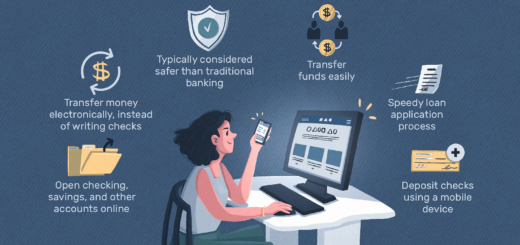The Origins and Evolution of Online Banking
Online banking has become an integral part of modern finance, but when did it all start? The history of online banking dates back to the early 1980s when banks started experimenting with computerized services. Over the years, online banking has evolved and transformed the way we manage our finances. Let’s take a closer look at the timeline and development of online banking.
Key Takeaways:
- Online banking originated in the early 1980s when banks began exploring computerized services.
- The true emergence of online banking came with the widespread adoption of the internet in the 1990s.
- Advancements in technology have led to the evolution of online banking, including the introduction of mobile banking and additional services.
- Online banking provides convenience, 24/7 access, faster transactions, and reduced reliance on physical branches.
- Security measures such as encryption, firewalls, and multi-factor authentication ensure the safety of online banking.
The Early Years: Introduction of Online Banking
In the 1980s, online banking began to reshape the traditional banking landscape as financial institutions embraced the potential of computer technology. During this era, banks started utilizing computers for internal operations, marking the origins of online banking.
The initial services offered through online banking allowed customers to check their account balances and view transaction histories. However, the functionality of these early systems was limited, and conducting transactions required customers to physically visit the bank.
Despite the constraints, the introduction of online banking laid the foundation for the transformative changes that would revolutionize the way we manage our finances in the years to come.
The Rise of Internet Banking
The true emergence of online banking came with the widespread adoption of the internet in the 1990s. Banks started offering internet banking services, allowing customers to access their accounts and perform transactions online. This significant milestone in the history of online banking revolutionized the way people manage their finances.
With the introduction of online banking, customers were no longer restricted by the operating hours of physical bank branches. They gained the convenience of accessing their accounts 24/7, eliminating the need for in-person transactions. Online banking opened up a world of possibilities, providing customers with greater control and accessibility over their financial affairs.
One of the key advancements that contributed to the success of internet banking was the implementation of secure protocols, such as Secure Socket Layer (SSL). These protocols ensured the privacy and security of online transactions, alleviating customers’ concerns about the safety of their financial information.
“Internet banking has transformed the way customers interact with their banks. It has made financial services more accessible, convenient, and secure,” said John Thompson, a banking industry expert.
As people began to embrace internet banking, banks continued to enhance their online platforms, offering a wider range of services and features. Customers could now not only view their account balances and transaction histories but also initiate fund transfers, pay bills, and even apply for loans online.
The rise of internet banking paved the way for a new era in the banking industry. It brought about a fundamental shift in customer expectations and banking practices, setting the stage for further innovations and advancements in the years to come.
The Benefits of Internet Banking
- Convenience: Internet banking allows customers to manage their finances anytime and anywhere, eliminating the need to visit a physical bank branch.
- Accessibility: Customers have 24/7 access to their accounts, enabling them to view transactions, check balances, and perform transactions at their convenience.
- Time-saving: Online banking eliminates the need for time-consuming tasks such as standing in lines or filling out paper forms for simple transactions.
- Security: With secure protocols in place, internet banking ensures the privacy and protection of customer information.
- Efficiency: Online banking offers fast and efficient transactions, enabling customers to complete tasks quickly and easily.
Internet banking has undoubtedly revolutionized the way we bank. As technology continues to evolve, we can expect further advancements that will shape the future of online banking, ensuring an even more seamless and personalized banking experience for customers.
The Evolution of Online Banking
As technology continued to advance, online banking underwent a significant evolution. The early 2000s marked a pivotal moment with the introduction of mobile banking, revolutionizing how customers accessed their accounts. The advent of smartphones and other mobile devices allowed individuals to manage their finances on the go, providing unparalleled convenience and accessibility.
In addition to mobile banking, banks began offering a range of new services online. Customers could now easily pay bills, transfer funds, and even apply for loans without stepping foot inside a physical branch. This accelerated the adoption of online banking, as customers appreciated the ease and efficiency of handling their financial needs from the comfort of their homes or offices.
With the development of online banking, banks prioritized enhancing security measures to ensure customer trust and protect sensitive information. Advanced encryption technologies and multi-factor authentication became common practices, safeguarding online transactions and mitigating the risk of fraud.
“The introduction of mobile banking marked a turning point in the evolution of online banking, enabling individuals to manage their finances anytime, anywhere. This increased convenience has transformed the way customers interact with their banks.” – John Smith, Banking Expert
Furthermore, online banking platforms began to offer personalized financial tools and insights, empowering customers to gain a deeper understanding of their financial health. With real-time transaction updates and tailored recommendations, individuals could make informed decisions about their spending, saving, and investment strategies.
Table: Evolution of Online Banking Services
| Year | New Online Banking Services |
|---|---|
| 2000 | Introduction of mobile banking |
| 2003 | Bill payment services |
| 2006 | Online fund transfers |
| 2009 | Online loan applications |
This continuous evolution of online banking has led to a more seamless and personalized banking experience for customers. Today, individuals can manage their finances with a few simple clicks or taps, thanks to the ongoing innovation in online banking services.
Online Banking Today
Today, online banking has become the norm, with millions of people around the world managing their finances online. The evolution of online banking has revolutionized the way we bank and has made financial management more accessible and convenient than ever before.
Banks continually strive to improve their online banking platforms, offering a range of advanced features to enhance the user experience and meet the evolving needs of their customers. These advancements have paved the way for a seamless and efficient banking experience in the digital age.
One of the key advancements in online banking is the introduction of biometric authentication. With features such as fingerprint scanning, facial recognition, and voice verification, banks have increased security measures to ensure the identity of their customers and protect against fraud.
Real-time transaction updates have also become a standard feature in online banking platforms. Customers can now receive instant notifications regarding their account balance, transaction history, and any suspicious activities, providing them with greater control and visibility over their finances.
Furthermore, personalized financial tools have been integrated into online banking platforms to help customers manage their money effectively. These tools offer insights into spending habits, budgeting assistance, and goal setting capabilities, empowering individuals to make informed financial decisions.
Online banking has revolutionized the way we manage our accounts, allowing customers to access their funds and perform transactions at any time, from anywhere in the world. With a simple login and the click of a button, individuals can transfer funds, pay bills, and even apply for loans or credit cards.

In conclusion, the evolution of online banking has transformed the financial landscape, offering convenience, security, and accessibility to customers worldwide. The constant advancements in online banking platforms continue to shape the way we manage our finances, providing us with an array of innovative features and personalized tools to enhance our banking experience.
Benefits of Online Banking
Online banking has revolutionized the way we manage our finances, offering numerous benefits that cater to the needs and demands of individuals and businesses alike. Let’s explore some of the key advantages that online banking brings.
1. Convenience
One of the major benefits of online banking is the convenience it offers. Gone are the days of having to visit a physical branch during limited operating hours. With online banking, you have 24/7 access to your account information and can perform transactions from the comfort of your home, office, or even while on the go. It saves time, eliminates the need for commuting, and empowers you to handle your finances at your convenience.
2. Remote Account Management
Online banking allows you to manage your finances remotely, giving you control over your accounts from anywhere in the world. Whether you’re traveling, living abroad, or simply unable to visit a branch, online banking ensures that your financial management is uninterrupted. You can check your balance, view transaction history, download statements, and even set up automatic alerts for account activity.
3. Reduced Reliance on Physical Branches
With online banking, you can decrease your reliance on physical bank branches. This not only saves time but also reduces the inconvenience of long queues and wait times. Online banking empowers you to complete various transactions without the need to visit a branch, such as transferring funds between accounts, paying bills, applying for loans, and managing investments.
4. Faster and More Efficient Transactions
Online banking enables faster and more efficient transactions. With just a few clicks, you can initiate electronic fund transfers, make bill payments, and even set up recurring payments for regular bills. This not only saves time but eliminates the need for writing checks, waiting for mail delivery, and manual processing, making online banking an efficient and streamlined option.
5. Enhanced Security Measures
Online banking platforms have implemented robust security measures to safeguard your financial information. Banks use encryption technology to protect your data and employ multi-factor authentication to ensure that only authorized individuals can access your accounts. In addition, you can monitor your account activity in real-time and receive instant alerts for any suspicious transactions, providing peace of mind and an added layer of security.
6. Financial Insights and Tools
Online banking platforms often provide personalized financial tools and insights to help you manage your money effectively. You can track your spending patterns, set budgets, and receive recommendations to achieve your financial goals. These tools empower you to make informed decisions about your finances and gain a deeper understanding of your financial health.
With its convenience, accessibility, and range of features, online banking has become an essential tool for individuals and businesses alike. It’s no wonder that more and more people are embracing online banking as their go-to method for managing their finances.
| Benefits of Online Banking | |
|---|---|
| Convenience | 24/7 access to account information and transactions from anywhere. |
| Remote Account Management | Manage finances from anywhere in the world. |
| Reduced Reliance on Physical Branches | Complete transactions without visiting a branch. |
| Faster and More Efficient Transactions | Initiate quick fund transfers, bill payments, and more. |
| Enhanced Security Measures | Encryption, multi-factor authentication, and real-time monitoring. |
| Financial Insights and Tools | Track spending, set budgets, and receive personalized recommendations. |
Security Measures in Online Banking
With the rise of online banking, security measures have become crucial to protect customers’ sensitive information. Banks employ various security protocols to ensure the safety of online transactions and to maintain the trust of their customers. Here are some of the key security measures implemented in online banking:
Encryption
Encryption is a fundamental security measure used in online banking. It involves converting sensitive information into unreadable code to prevent unauthorized access. Banks use advanced encryption algorithms to secure customer data during transmission and storage, making it highly difficult for hackers to intercept or decipher.
Firewalls
Firewalls act as a barrier between the bank’s network and external networks, filtering out potential threats and unauthorized access attempts. They block malicious traffic and ensure that only legitimate requests are allowed, thus protecting customer data from unauthorized access.
Multi-Factor Authentication
Multi-factor authentication adds an extra layer of security to online banking by requiring users to provide multiple forms of identification. This typically involves a combination of something the user knows (such as a password), something the user has (such as a mobile device), or something the user is (such as biometric data). By combining these factors, online banking systems can verify the identity of the user more effectively.
“The security measures in place in online banking are designed to safeguard customer information and protect against unauthorized access. Banks invest heavily in advanced technologies to ensure the utmost security for their customers.”
Safe Online Banking Practices
In addition to the security measures implemented by banks, customers also play a vital role in ensuring the safety of their online banking experience. Here are some safe online banking practices:
- Regularly update passwords and choose strong, unique ones.
- Avoid sharing personal information or login credentials with others.
- Be cautious of phishing emails or suspicious websites asking for sensitive information.
- Monitor account activity regularly and report any unauthorized transactions immediately.
By following these practices, customers can further enhance the security of their online banking transactions and protect their financial information.
Overall, security measures in online banking have significantly advanced over the years to protect customers from fraud and keep their sensitive information secure. With encryption, firewalls, multi-factor authentication, and safe online banking practices, customers can enjoy the convenience and benefits of online banking while ensuring their safety.
Future Trends in Online Banking
The future of online banking holds immense potential, fueled by advancements in technology and consumer demand for more seamless and personalized financial experiences. As we look ahead, several key trends are emerging that will shape the future landscape of online banking.
1. Artificial Intelligence (AI) in Online Banking
Artificial intelligence is revolutionizing the banking industry, and online banking is no exception. AI-powered chatbots and virtual assistants are becoming more sophisticated, allowing customers to interact with their banks in real-time, ask questions, and receive immediate assistance. AI algorithms are also being utilized to analyze customer data and behavior, providing personalized recommendations and improving the overall banking experience.
2. Biometric Authentication for Enhanced Security
With the increasing need for robust security measures, biometric authentication is gaining traction in online banking. Technologies such as fingerprint recognition, facial recognition, and voice recognition are being integrated into banking applications, ensuring secure access to accounts and providing an extra layer of protection against fraud and identity theft.
3. Blockchain Technology for Secure and Transparent Transactions
Blockchain technology, known for its decentralized and tamper-proof nature, has the potential to revolutionize online banking. It enables secure and transparent transactions by eliminating intermediaries and providing a permanent record of all transactions. The use of blockchain can streamline cross-border payments, reduce transaction costs, and enhance trust between banking institutions and customers.
4. Personalized Financial Management Tools
As online banking continues to evolve, financial institutions are focusing on providing customers with personalized financial management tools. These tools leverage customer data and AI algorithms to offer tailored budgeting, goal-setting, and financial planning advice. With these tools, customers can gain better insights into their spending habits, save more effectively, and make informed financial decisions.
5. Integration of Internet of Things (IoT) Devices
The Internet of Things (IoT) is expanding rapidly, and online banking is tapping into its potential. IoT devices such as smartwatches, fitness trackers, and home automation systems can seamlessly integrate with online banking platforms, allowing customers to monitor their accounts, initiate payments, and receive real-time financial updates through smart devices. This integration enhances convenience and accessibility, providing customers with greater control over their finances.
6. Enhanced Cybersecurity Measures
As online banking evolves, so do the threats and risks associated with cybercrime. Banks are investing heavily in strengthening their cybersecurity measures to combat emerging threats. These measures include advanced encryption protocols, multi-factor authentication, and real-time monitoring systems. Collaboration between financial institutions, government bodies, and technology experts is essential to ensure online banking remains safe and secure.
As these trends continue to shape the future of online banking, customers can expect a more seamless, secure, and personalized banking experience. The evolution of technology and customer expectations will drive further innovation, making online banking an integral part of our financial lives.
Online Banking Regulations and Compliance
As online banking has grown in popularity, regulatory bodies have played a crucial role in ensuring the safety and integrity of financial transactions. Financial institutions are bound by various regulations that aim to protect customers and maintain transparency in online banking.
Bank Secrecy Act: The Bank Secrecy Act (BSA) is a U.S. federal law that requires financial institutions to assist government agencies in preventing money laundering, fraud, and other financial crimes. It imposes reporting and record-keeping obligations on banks to promote transparency and deter illicit activities.
Anti-Money Laundering (AML) Laws: AML laws are measures put in place to combat money laundering and the financing of terrorism. Financial institutions are required to establish robust policies and procedures to detect and report suspicious activities. Regular training programs and risk assessments are necessary to ensure compliance.
Data Protection Regulations: With the increasing digitization of financial transactions, protecting customer data has become paramount. Financial institutions must comply with data protection regulations such as the General Data Protection Regulation (GDPR) and the California Consumer Privacy Act (CCPA). These regulations ensure the secure handling and processing of personal information.
The Impact of Regulations on Online Banking
Complying with online banking regulations is not just a legal requirement; it has significant implications for financial institutions and their customers. Regulations help establish trust in online banking systems, safeguarding sensitive information and mitigating the risk of financial crimes. By adhering to strict compliance standards, banks can foster customer loyalty and protect their reputation.
Financial institutions devote substantial resources to ensure compliance with online banking regulations. Robust compliance programs, regular audits, and compliance officers are integral to meeting regulatory requirements. Additionally, technologies such as encryption, multi-factor authentication, and real-time fraud monitoring help strengthen security measures and detect suspicious activities.
While regulations provide the framework for secure online banking, it is also essential for customers to take an active role in protecting themselves. This includes regularly monitoring account activity, using strong and unique passwords, and being cautious of phishing attempts or suspicious emails.
| Benefits of Online Banking Regulations and Compliance |
|---|
| Enhanced customer trust and confidence in online banking systems |
| Protection against financial crimes such as money laundering and fraud |
| Maintained transparency and accountability in financial transactions |
| Prevention of data breaches and unauthorized access to customer information |
| Establishment of industry standards for secure online banking practices |
Compliance with online banking regulations ensures that financial institutions operate in a responsible and secure manner. By safeguarding customer interests and maintaining transparency, both individuals and businesses can confidently utilize online banking services, contributing to a thriving and trustworthy financial ecosystem.
The Impact of Online Banking on the Banking Industry
The advent of online banking has revolutionized the banking industry, transforming the way financial institutions operate and serve their customers. Traditional brick-and-mortar banks have had to adapt to the changing landscape by investing heavily in online banking platforms and services.
Online-only banks, also known as neobanks, have emerged as formidable players in the industry. These digital-only banks provide customers with convenient and frictionless banking experiences, leveraging technology to streamline processes and offer innovative financial solutions.
The rise of online banking has created intense competition among banks, driving innovation and improvement in customer experiences. Financial institutions now strive to differentiate themselves by offering user-friendly interfaces, personalized services, and cutting-edge features to attract and retain customers.
“The emergence of online banking has given customers more control over their finances, allowing them to access their accounts, transact, and manage their money conveniently and securely from anywhere.”
Online banking has also enabled banks to reach a larger customer base beyond their physical branch locations. This increased accessibility has opened up opportunities for financial inclusion, empowering individuals who may have previously faced barriers in accessing traditional banking services.
Moreover, online banking has brought significant benefits to customers and the banking industry as a whole.
Benefits of Online Banking
1. Convenience: Online banking provides customers with the flexibility to bank at their convenience, eliminating the need to visit physical branches during restricted banking hours. Users can access their accounts, perform transactions, and manage their finances 24/7 from any internet-enabled device.
2. Enhanced Accessibility: With online banking, customers can view their account information, transaction history, and statements instantly, providing them with real-time insights into their financial health. This accessibility empowers individuals to make informed decisions regarding their money.
3. Streamlined Transactions: Online banking facilitates quick and seamless transactions, allowing users to transfer funds, pay bills, set up automatic payments, and make remote deposits with ease. These streamlined processes save time, reduce paperwork, and minimize errors.
4. Cost Savings: Online banking eliminates the need for customers to incur expenses related to physical branch visits, such as transportation costs and time spent commuting. It also reduces paper usage and associated costs, contributing to a greener environment.
5. Enhanced Security: Banks prioritize the security of online banking platforms, implementing robust security measures such as encryption, multi-factor authentication, and fraud detection systems. These measures help protect customer data and transactions, providing peace of mind for users.

The impact of online banking on the banking industry is undeniable. It has reshaped the way banks operate, improved customer experiences, and fostered innovation. As technology continues to advance, online banking will continue to evolve, offering even greater convenience, security, and financial opportunities for individuals and businesses alike.
Conclusion
Throughout its history, online banking has revolutionized the way we manage our finances, providing a convenient and secure platform for individuals and businesses. Starting in the 1980s, online banking has evolved from basic account balance checking to a comprehensive suite of services, accessible anytime and anywhere. With constant technological advancements, online banking will continue to shape the future of the banking industry, offering personalized and efficient services.
The emergence of online banking in the 1980s marked the beginning of a transformative era in finance. As the internet gained popularity in the 1990s, online banking became more accessible, allowing customers to perform various transactions remotely. The introduction of mobile banking in the early 2000s further enhanced convenience, enabling users to manage their finances using smartphones and other mobile devices.
Today, online banking has become the norm, with millions of people worldwide relying on its benefits. Customers enjoy 24/7 access to their account information, the ability to make faster transactions, and reduced reliance on physical bank branches. With robust security measures in place, such as encryption and multi-factor authentication, online banking ensures the privacy and safety of financial transactions.
Looking ahead, the future of online banking holds promise. Advancements in technology, such as artificial intelligence and blockchain, will bring forth innovative solutions that further enhance the banking experience. Customers can expect more personalized services, enhanced security features, and improved financial management tools. As online banking continues to evolve, it will undoubtedly shape the future of the banking industry, delivering greater convenience and efficiency for customers.
FAQ
When did online banking start?
Online banking started to take shape in the 1980s when banks began experimenting with computerized services.
What is the history of online banking?
The history of online banking dates back to the early 1980s, with the emergence of computerized services in banks.
What are the origins of online banking?
The origins of online banking can be traced back to the 1980s when banks started using computers for their internal operations.
How has online banking evolved over time?
Online banking has evolved from basic account balance checking to offering a wide range of services such as bill payment, fund transfers, and loan applications.
What is the timeline of online banking?
Online banking began to take shape in the 1980s, gained momentum in the 1990s with the widespread adoption of the internet, and has continued to evolve ever since.
What is the introduction of online banking?
The introduction of online banking refers to the time when banks started offering internet banking services, allowing customers to access their accounts and perform transactions online.
How has online banking emerged?
Online banking emerged with the widespread adoption of the internet in the 1990s, enabling banks to offer internet banking services to their customers.
What is the development of online banking?
The development of online banking involves the continuous improvement of technology and services offered by banks to provide customers with more convenient and seamless online banking experiences.
How did online banking come into existence?
Online banking came into existence as banks started using computers for their internal operations in the 1980s.
What is the inception of online banking?
The inception of online banking refers to the early stages of its development when banks started experimenting with computerized services in the 1980s.

















It's great that you talked about how business insurance can provide financial protection against unexpected events and help ensure the…
I like that you mentioned how business insurance is essential for protecting your bottom line and the long-term viability of…